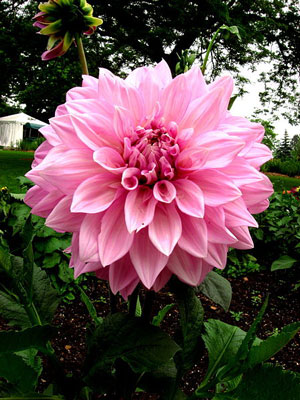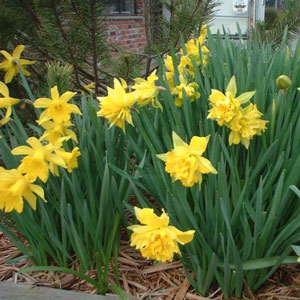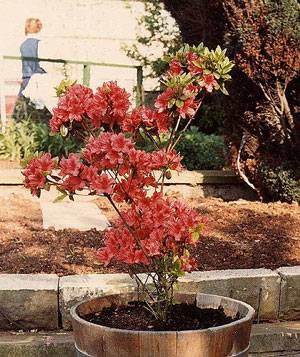
As some gardeners in the southeastern part of the United States are already beginning to enjoy a few veggies, and flowers from their gardens, other regions of the country planted later in June or even July due to weather conditions. USARiseUp tracked down Sheri Ann Richerson, one of the authors of the #1 best-seller, "Complete Idiot's Guide to Year-Round Gardening," and asked some questions about summer gardening.
Is mixing flower and vegetable plants a good idea?
Don’t be afraid to mix and match a combination of flowers, herbs, and vegetables. Growing these plants in combination with each other, helps prevent bugs, sometimes disease, as well as allowing the plants to grow better than they would on their own. This technique known as companion planting is thousands of years old. One example of this is planting marigolds next to tomatoes to help keep nematodes from destroying your tomato plants.
What is an annual and when do you plant them?
Annuals are plants that flower, set seed and die in one season. You can direct sow or transplant seedlings of annuals as soon as the last spring frost is over.
When do you plant herbs?
The best month to plant seeds, or buy seedlings of both annual and perennial herbs is in June. The earlier you start these plants, the quicker the harvest.
 What are perennials?
What are perennials?
A perennial is a plant that comes back from its own root system every year. Early summer is a great time to plant the fall blooming perennials as it gives the root system a chance to fully establish before beginning to bloom.
What about vegetables?
Depending on where you live, most people plant vegetables and fruits like seeds of cucumbers, beans, squash, corn, carrots, collards, zucchini, cantaloupe, and watermelon in June. Transplant warm weather vegetable seedlings such as tomatoes, eggplant, and peppers in the garden as well as any container plants to allow them to establish root systems by the time the heat of summer arrives.
To plant summer bulbs such as canna, pineapple, or calla lilies, and move houseplants or tropical plants back out to the garden, first, place them in a shady area for an hour or two a day for the first week to help them adjust. Strong winds, sunlight, and heavy rains can break plant foliage or burn the leaves if they are not accustomed to these conditions.
What kinds of things can be planted in the July garden?
Vegetables to plant this month include corn, beans, broccoli, lettuce, cucumbers, cabbage, cauliflower, kale, and turnips. Add more seeds to flowerbeds, including celosia, salvia, sunflowers, and sweet William. Gardeners in the far north may need to sow these flower seeds inside a greenhouse or high tunnel to protect them from early fall frost. If your high tunnel or cold frame is moveable, sow them in the open garden. Plant cool season crops such as lettuce, broccoli, or kale, in either natural or man-made shade by using lattice or shade cloth. This will help prevent these plants from bolting. When a plant bolts, it becomes bitter and sets seed.
What about August?
August is for planting winter radish, turnips, beans, cucumbers, carrots, lettuce, spinach, and broccoli in the vegetable garden. In the flower garden, sow seeds of delphinium, poppy, baptisia, heuchera, iris, and other perennials.
 Is mulching a good idea?
Is mulching a good idea?
Mulch helps keep weeds down while keeping the plant roots cool and preventing the soils natural moisture from evaporating. Use 3 inches of compost in flower, herb, and vegetable beds for mulch. The bees and butterflies need to access the soil for the minerals, try not to mulch every square inch with bark. I mulch my pathways with straw, and in weedy areas of the garden, I use shredded paper to keep weeds from growing. Spraying vinegar on weeds in sidewalks or driveways on a hot sunny day will kill them, but do not allow the vinegar to get on any plants you want to keep growing.
Compost regulates the warming and cooling of the soil, and attracts earthworms to aerate and work the nutrients into the soil. The healthier the plant, the less likely pests, and disease will affect it. Deadhead your flowers to keep them blooming all season long. Deadheading is the removal of faded flower. Deadheading does not work on all flowers, but flowers that respond well to deadheading include re-blooming roses, coneflower (Echinacea), daisy, phlox, yarrow, and annuals such as salvia or marigolds.
Most plants need an inch of water per week. There are self-watering timers that will measure the amount of natural water received and only water the garden if adequate natural rainfall did not occur. Soaker hoses are best because they water at the root system. Overhead watering can cause disease because the plants stems and foliage get wet. Water as early in the morning as possible so the excess water can evaporate before nightfall.
 What fertilizer do you recommend?
What fertilizer do you recommend?
I use all-natural kelp because it has everything in it that plants need, and I sometimes supplement container-grown tropicals with a slow release fertilizer. Roses love kelp! In the vegetable and fruit garden, using kelp improves the health of the plants. The plant roots take up all the minerals and use them when producing the fruits or vegetables. When we eat plants grown in kelp, we get some of those minerals too!
When is the best time to prune?
The correct time to prune is right after a plant flowers or fruits. This way you are not sacrificing fruit or flower production.
Richerson's books hold a wealth of information for the beginning or advanced gardener. In addition to her advice, here are a few more tips for successful summer gardening.
- Plan your garden areas to have color from spring until the end of fall. Use plants like Dusty Miller and Coleus to add color, height, and texture to flowerbeds.
- Check the local nursery for native plants are indigenous to your area. By using native plants, you will need less water, saving you money.
- Don't grow more than you can eat and try to stagger vegetable plantings for a longer harvest.
- Shopping at flea markets and small dollar stores will save money.
- Sales at the end of May when many gardeners are done planting will often leave stores with excess inventory, which in turn leads to great sales.
- Open houses or garden tours offer great ideas for new things to do in your garden.
- Always wear gloves when gardening to prevent fungus and infection in your hands.
- Place birdhouses in as many trees near your gardening area as possible. Birds love to eat insects, and that includes the nasty little critters that destroy your beautiful fruits, veggies, and flowers.
- Hang a piece of strong smelling soap on bamboo poles at varying heights to keep deer and rabbits out of your garden area.
